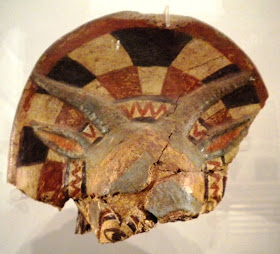
These two photos show terracotta acroteria of the head of Juno Sospita from a temple of Juno that was once on the Palatine Hill. They are now in the Palatine Museum, a museum that seems to be open every day - even Mondays when other museums in Rome are closed. When I first saw these in 2006 I was quite struck by Juno's goat-skin headdress because it looked to me a lot like... well, what we would now expect a certain founder of The Church of Satan to be wearing - as if a goat-skin really means the Satan of the New Testament (as the ha' satan of the Hebrew Bible is another thing altogether)! Consequently when I was in Rome in 2009 I marched through the Roman Forum in the boiling midday heat and up on to the Palatine Hill, almost getting heat-stroke, to find the museum to have another look at these terracotts and photograph them. So here they are. And what can I say about Juno Sospita? Well, according to Price and Kearns in the "Oxford Dictionary of Classical Myth and Religion" p.305, the cult of Juno Sospita was imported to Rome from the city of Lanuvium which from 338 BCE was administered jointly with Rome. The distinctive iconography of this goddess, who wears a goatskin and carries a spear and shield, indicates a martial character. Dumezil believed that her full epithet Sospita Mater Regina confirmed his thesis that Juno was originally trivalent, with influence over military prowess, fertility and political organisation. In Beard, North and Price's "Religions of Rome Vol 2: A Sourcebook" p.37-8 Cicero is quoted (On the Nature of the Gods I. 77, 81-2) saying "...Just as much, I'd swear, as you believe in the divinity of that Juno Sospita of your own native town - the one you never see, not even in your dreams, without a goat-skin, spear, shield and shoes turned up at the toe. But the Argive Juno does not appear like that, nor the Roman. So it follows that Juno has one appearance for the Argives, another for the people of Lanuvium, another for us." Anyway, while I am less amazed at her goat-skin headdress than I once was, I still think it's pretty remarkable. See these interesting coins with Juno on them.



